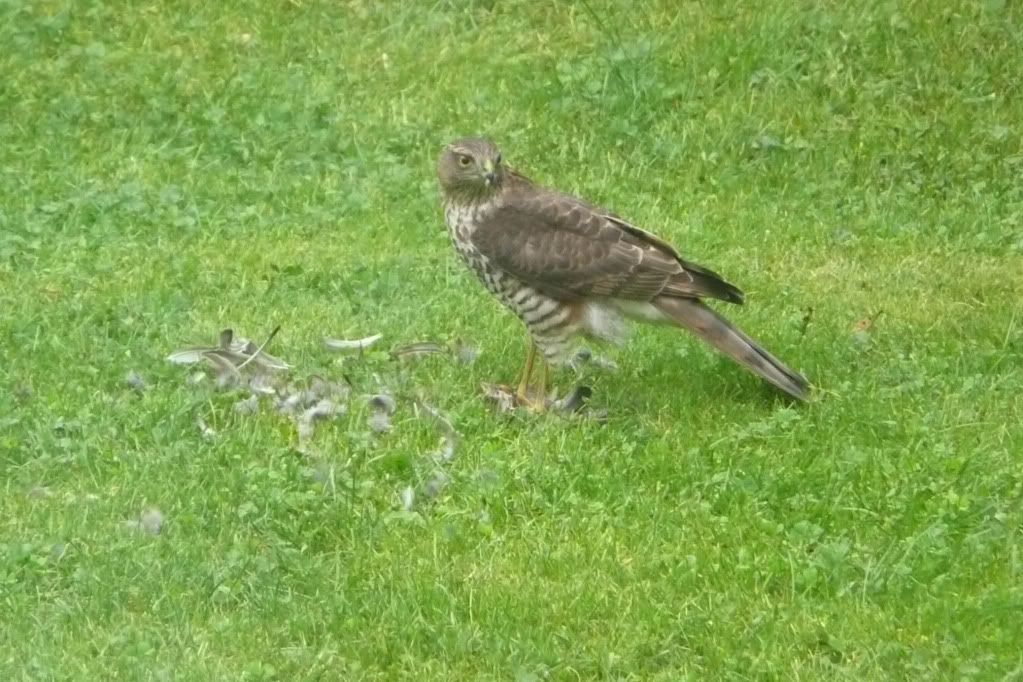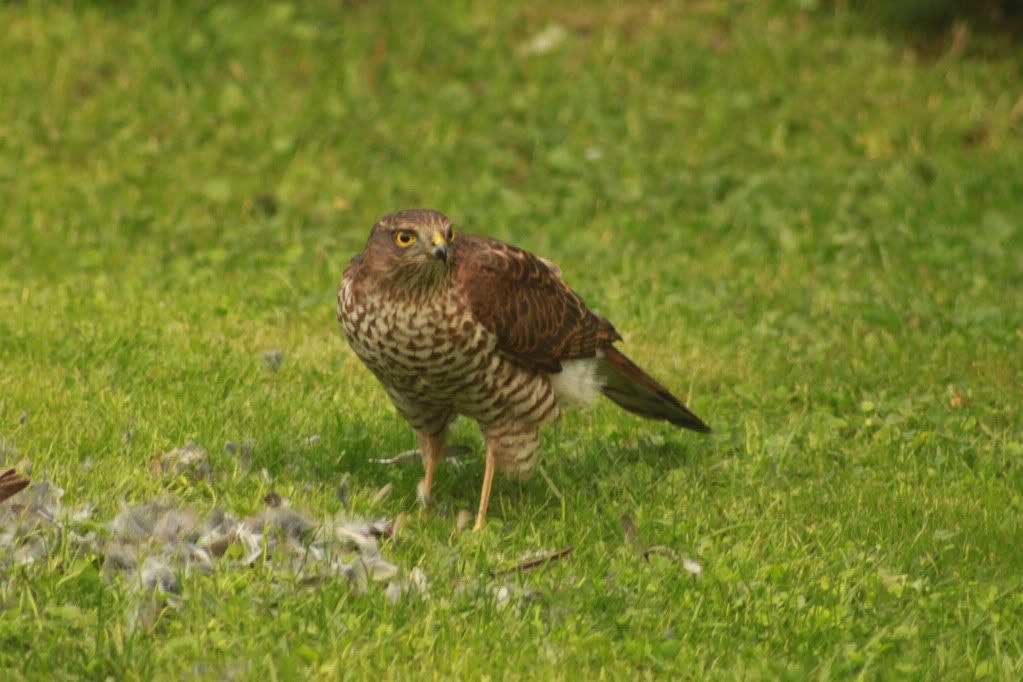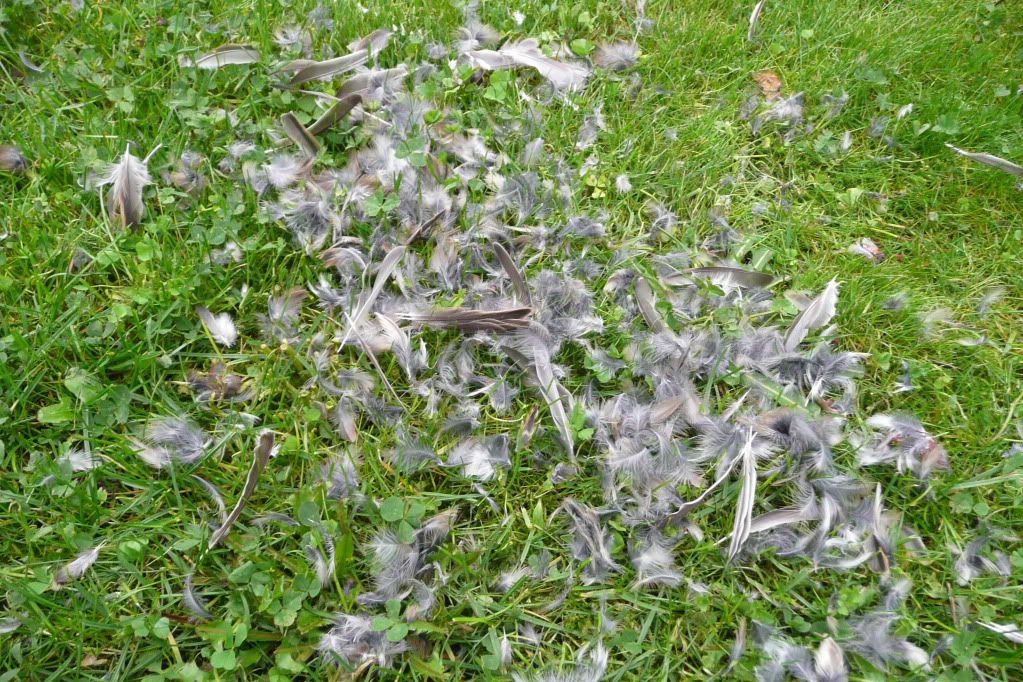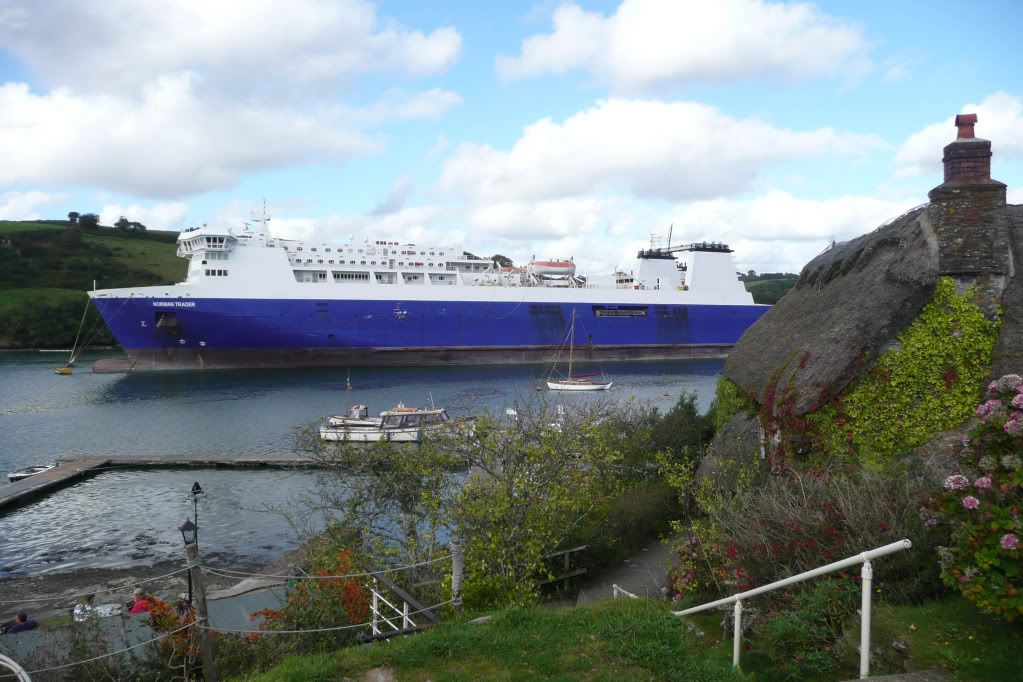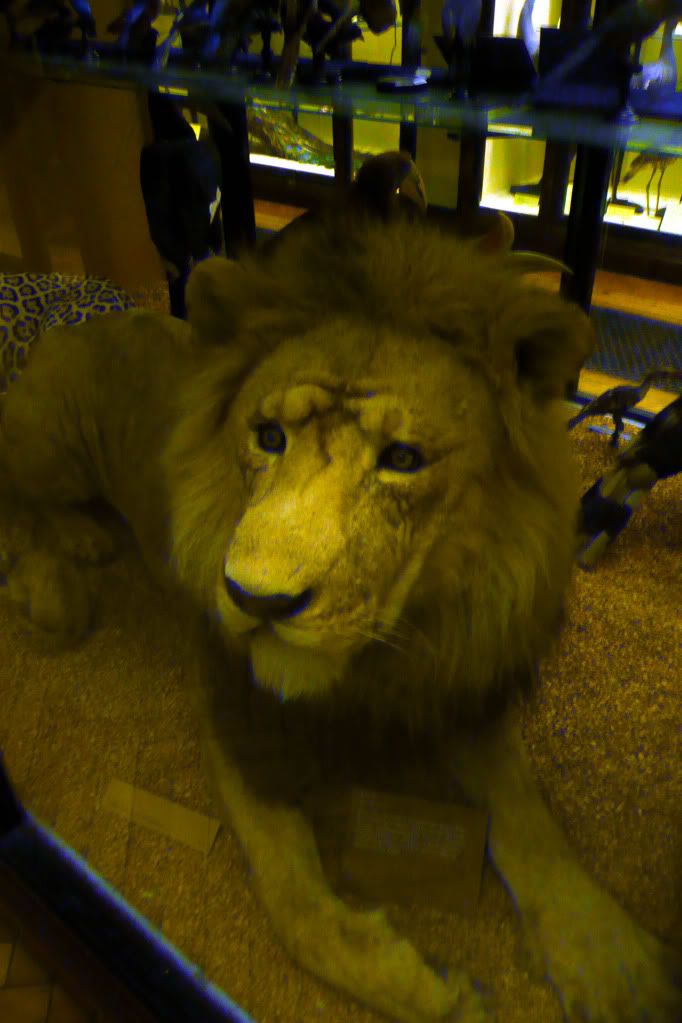Sparrowhawks are infrequent visitors to our garden, the previous visitor has been an adult male - with a grey back and an orange front. But this one is different:
.
.
The brown back and brown front indicate it could be a young male, maybe even raised by the mature male which lasted visited the garden back in October last year (http://viewsoftheock.blogspot.com/2010/10/birds-of-prey.html).
.
.
Judging the pile of feathers, it seems to have successfully mastered the skill of hunting and from the remains, it seems it's victim is a house sparrow or a dunnock.
What is interesting is the complete lack of bones and internal organs, just feathers - the sparrowhawk had consumed it all.
.
.
What is also surprising was nonchalant it appeared, occasionally looking up as it devoured it's unfortunate victim for several minutes and then giving a glimpse of some seldom seen behaviour before leaving:
.
Wildlife and other things of interest on and around the river Ock in south Oxfordshire
Wednesday 28 September 2011
Sunday 25 September 2011
Views of the Fal
Rising near St Austell, the river Fal is one of numerous rivers which flow into the Fal estuary in Cornwall and is an idylic place to explore on an early autumn holiday.
The ferry from Truro to Falmouth (and St. Mawes) is an excellent way to explore the river system, with it's creeks and sail boats.
.
.
The south of Cornwall is famous for it's gardens, including Trelissick - owned and managed by the national trust since 1955. Where the banks of the Fal provide the ideal habitat for the rare shrubs which grow there).
.
The river fal is the third deepest natural harbour in the world, as a consequence it is has become a rather strange barometer of the worlds economic climate. Huge ships (up to a 100,000 ton) are mothballed here, either awaiting to be recommissioned, scrapped or sold.
The current fashion is for ferries, here two are moored by the gardens.
The ferry from Truro to Falmouth (and St. Mawes) is an excellent way to explore the river system, with it's creeks and sail boats.
.
.
The south of Cornwall is famous for it's gardens, including Trelissick - owned and managed by the national trust since 1955. Where the banks of the Fal provide the ideal habitat for the rare shrubs which grow there).
.
The river fal is the third deepest natural harbour in the world, as a consequence it is has become a rather strange barometer of the worlds economic climate. Huge ships (up to a 100,000 ton) are mothballed here, either awaiting to be recommissioned, scrapped or sold.
The current fashion is for ferries, here two are moored by the gardens.
.
Another passenger ferry provides a somewhat strange view from the Smugglers Inn - it also obscures the view of the only tea plantation in the UK. Which the inn servers along with that staple of Cornish holidays (apart from pasties), the cream tea.
.
Wednesday 7 September 2011
Natural History Museum at Tring
Located only a few miles from College Lake is the Natural History Museum at Tring. It was built for and still houses the collection of Lionel Walter Rothschild, 2nd Baron Rothschild.
Walter Rothschild was an eccentric, in the only way a Victorian from a very wealthy banking family could be. Having failed to make the grade in the family's bank he dedicated his life to amassing an extraordinary collection of dead animals, including:
Spread over five floors the museum is a jaw dropping monument to one man's obsession with killing and stuffing animals.
.
.
Some of these seem to be rather poorly done, rather than looking like apex predators, the lion and polar bear just look like giant soft toys:
.
.
In his book, A short history of nearly everything, Bill Bryson describes the sad story of the lesser koa finch, a small Hawaiian bird; only one has ever been seen and this was when it was shot for Rothschild's collection.
The finch, along with the majority of Rothschild's bird collection, was sold to the American Museum of Natural History in order to pay off a woman who had been blackmailing him for years. Even so, most of his British bird collection remains at Tring, including this family of grey partridges:
.
.
It's easy to be critical of Rothschild and is obsession with killing and stuffing animals, certainly the mountain gorilla would be laughable if wasn't so tragic. But employed skilled zoologists, entomologists and ornithologists who helped him catalogue the collection, and in the process discover over 5000 new species, and published 1,700 scientific books.
Even today, the museum plays an important role for illustrators of field guides and for helping to identify recently discovered birds, like the Indian warbler.
Walter Rothschild was an eccentric, in the only way a Victorian from a very wealthy banking family could be. Having failed to make the grade in the family's bank he dedicated his life to amassing an extraordinary collection of dead animals, including:
- 2000 mammals
- 2000 birds
- 2,000,000 butterflies and moths
- 300,000 beetles
- 300,000 bird skins
- 200,000 bird eggs.
Spread over five floors the museum is a jaw dropping monument to one man's obsession with killing and stuffing animals.
.
.
Some of these seem to be rather poorly done, rather than looking like apex predators, the lion and polar bear just look like giant soft toys:
.
.
In his book, A short history of nearly everything, Bill Bryson describes the sad story of the lesser koa finch, a small Hawaiian bird; only one has ever been seen and this was when it was shot for Rothschild's collection.
The finch, along with the majority of Rothschild's bird collection, was sold to the American Museum of Natural History in order to pay off a woman who had been blackmailing him for years. Even so, most of his British bird collection remains at Tring, including this family of grey partridges:
.
.
It's easy to be critical of Rothschild and is obsession with killing and stuffing animals, certainly the mountain gorilla would be laughable if wasn't so tragic. But employed skilled zoologists, entomologists and ornithologists who helped him catalogue the collection, and in the process discover over 5000 new species, and published 1,700 scientific books.
Even today, the museum plays an important role for illustrators of field guides and for helping to identify recently discovered birds, like the Indian warbler.
Monday 5 September 2011
College Lake
Situated on the Buckinghamshire and Hertforshire border is College Lake, a former chalk quarry, now the BBOWT flagship reserve.
When quarrying was ceased in the 1980 the pit was allowed to flood, forming a habitat for summer breeding birds and winter migrants:
.
.
The new lottery funded visitors centre now features a cafe, a display of the mammoth tusks found when the quarry was active and best of all - the chemical toilets have been replaced.
The centre features a splendid living roof of local plant life (even if the lawns are not yet complete) and expansive windows to enjoy the lakes which make up the reserve.
.
.
The two mile walk around the lake is unchanged and the sheep continue to graze the reserve in order to create wildflower meadows on the chalk banks surrounding the lakes:
.
.
Old mining equipment, once used to dig out the quarry has, become a display, looking almost like an installation of modern art
.
.
College Lake makes a great walk in late summer / early autumn, but there isn't much wildlife about - the summer breeding birds have mostly gone and the winter migrants have not yet arrived. Although there was a kestrel, a couple of woodpeckers and a flock of lapwings, somewhat hard to see in this picture.
.
.
College Lake will be a more hospitable in the winter, rather than freezing in one of the hides, it will be nice to be sipping a hot chocolate in the warm and watching the birds.
When quarrying was ceased in the 1980 the pit was allowed to flood, forming a habitat for summer breeding birds and winter migrants:
.
.
The new lottery funded visitors centre now features a cafe, a display of the mammoth tusks found when the quarry was active and best of all - the chemical toilets have been replaced.
The centre features a splendid living roof of local plant life (even if the lawns are not yet complete) and expansive windows to enjoy the lakes which make up the reserve.
.
.
The two mile walk around the lake is unchanged and the sheep continue to graze the reserve in order to create wildflower meadows on the chalk banks surrounding the lakes:
.
.
Old mining equipment, once used to dig out the quarry has, become a display, looking almost like an installation of modern art
.
.
College Lake makes a great walk in late summer / early autumn, but there isn't much wildlife about - the summer breeding birds have mostly gone and the winter migrants have not yet arrived. Although there was a kestrel, a couple of woodpeckers and a flock of lapwings, somewhat hard to see in this picture.
.
.
College Lake will be a more hospitable in the winter, rather than freezing in one of the hides, it will be nice to be sipping a hot chocolate in the warm and watching the birds.
Subscribe to:
Posts (Atom)
